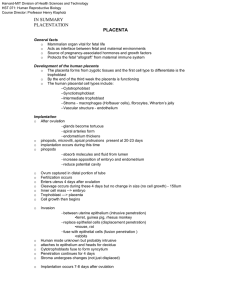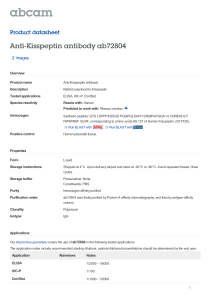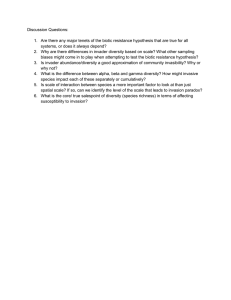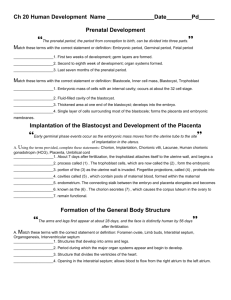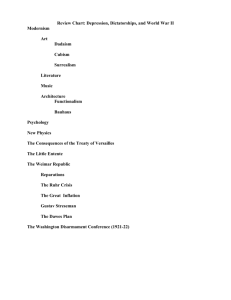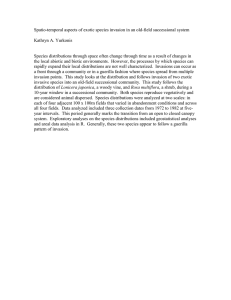An embryonic model for trophoblast invasion Contents James Muir April 12, 2007
advertisement
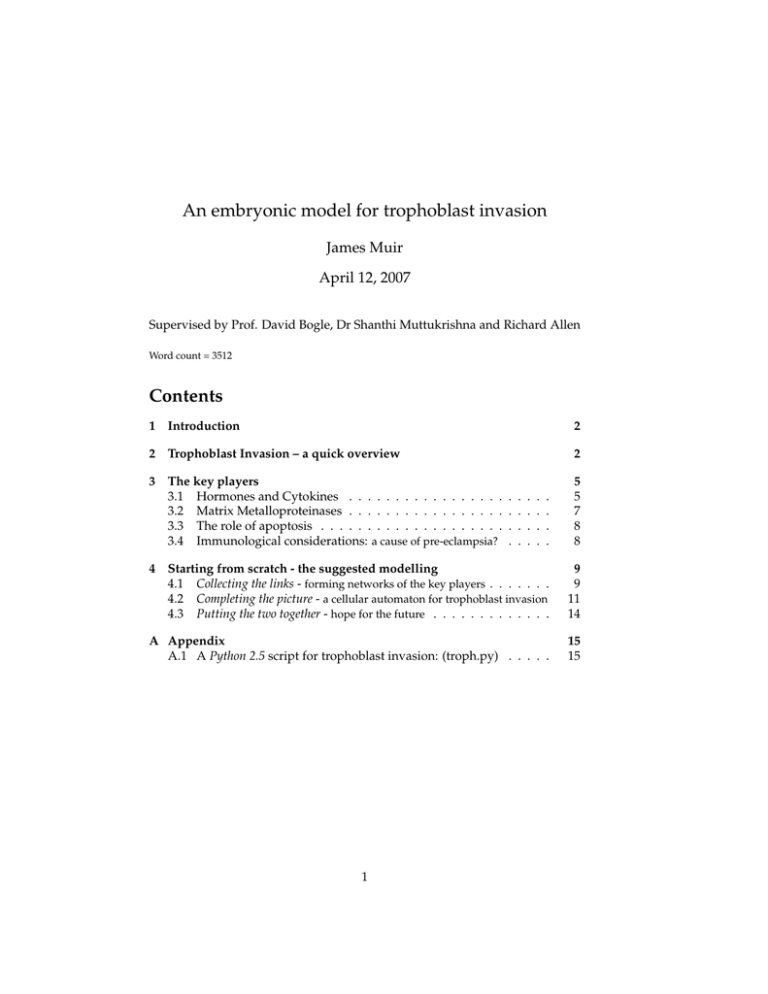
An embryonic model for trophoblast invasion James Muir April 12, 2007 Supervised by Prof. David Bogle, Dr Shanthi Muttukrishna and Richard Allen Word count = 3512 Contents 1 Introduction 2 2 Trophoblast Invasion – a quick overview 2 3 The key players 3.1 Hormones and Cytokines . . . . . . . . . . . . . . . . . 3.2 Matrix Metalloproteinases . . . . . . . . . . . . . . . . . 3.3 The role of apoptosis . . . . . . . . . . . . . . . . . . . . 3.4 Immunological considerations: a cause of pre-eclampsia? . . . . 5 5 7 8 8 Starting from scratch - the suggested modelling 4.1 Collecting the links - forming networks of the key players . . . . . . . 4.2 Completing the picture - a cellular automaton for trophoblast invasion 4.3 Putting the two together - hope for the future . . . . . . . . . . . . . 9 9 11 14 A Appendix A.1 A Python 2.5 script for trophoblast invasion: (troph.py) . . . . . 15 15 4 1 . . . . . . . . . . . . . . . . 1 Introduction From the fusing of sex cells to the birth of young, the journey of development is without question one of the most astounding processes in nature. The role of trophoblasts – cells that fringe the conceptus – is absolutely crucial, and in humans, twofold: to firstly invade the maternal uterine tissue, anchoring the fetus to the mother, and then to develop the placenta. The placenta is a unique fetal-maternal organ. Trophoblastic remodelling of uterine tissue creates passive conduits that allow oxygen and nutrient perfusion into the fetal blood and removal of waste from it. Throughout this process (which is completed mid-term), there exists a complex fetal-maternal exchange into which a huge research effort is being poured. Various trophoblast-specific aspects of this crosstalk will be reviewed here, both in normal pregnancy and in complications such as pre-eclampsia (loosely, invasion is not deep enough) and choriocarcinoma (trophoblasts out of control). At present, computational modelling appears to be completely absent from the literature. I will ”start from scratch” and present some very embryonic1 ideas which may find use – with more data from experiment – if such an in silico approach were to be adopted. Namely, these are the Cellular Automata (widely used in biological modelling) and network-type approaches commonly employed in Systems Biology. 2 Trophoblast Invasion – a quick overview By way of a quick overview, here is a summary of what happens in attachment, implantation and establishment of pregnancy in humans. At the 32-64 cell stage, blastocyst cells (i.e. those that make up the conceptus) distinguish into two types, one of which is the trophoblast. These extraembryonic cells form an outer rim and their function, as we will see, is crucial to development. At the 128-cell stage, this lineage is distinct from the inner mass cells, which will go on to form the embryo [11]. On day 7, the conceptus attaches to the uterine wall, which is already beginning to decidualise, i.e. change structurally and biochemically in anticipation of pregnancy (one of many developmental features unique to humans [6]). Within a few hours of attachment, the surface epithelium becomes eroded, and the first trophoblast invasion of the underlying uterine tissue commences. In humans, the conceptus is so deeply anchored that the surface epithelium becomes restored over it. This is known as interstitial implantation, and also occurs in chimps and guinea pigs [5]. Invasive implantation occurs in the mouse, and has been extensively studied both in vivo and in vitro. Human implanta1 please excuse the pun 2 Pre-eclampsia is the name given to the hypertension and swelling seen before eclampsia – Greek for ”bolt from the blue” – characterised by fits. It affects around 5% of pregnant women. Choriocarcinoma is malignant cancer of the chorion (the name given to the fetal side of placenta) and develops from its benign counterpart hydatidiform mole, which arises at random due to a genetic error during fertilization. The fetus is viable in neither. tion is the most invasive, and this is thought to be due to our enlarged brain and bipedalism [11]. A schematic diagram of implantation is found in Figure 1. Figure 1: A schematic of interstitial implantation by the human conceptus. The initial invasion of the endometrium embeds the fetus in the uterine wall. Trophoblastic differentiation occurs within the first few weeks: finger-like anchoring villi – made up of cytotrophoblasts (which serve as a proliferative source) and lined with syncitiotrophoblasts (their fused counterpart) – make contact with the decidua and form the early placenta. A cell column of extra-villous cytotrophoblasts at the tip of each villus generates those that go on to perform a second function; invasion into the decidua and remodelling of the mother’s spiral arteries, creating a large surface for fetal-maternal perfusion [17]. This is shown schematically in Figure 2. Throughout this process, trophoblast invasion is regulated by a whole host of different factors. These include, but are by no means limited to: hormones, growth factors, cytokines, matrix metalloproteinases, apoptotic factors and immunological interactions. Each of these will be discussed in turn, and the links between them will help create a ”network” that encompasses some of the important parts of this intricate fetal-maternal exchange. With so many pregnancy complications being trophoblast-related, the research goal is a better understanding of how trophoblast invasion is regulated and a ”pinning down” of the key factors involved. 3 Figure 2: Extra-villous cytotrophoblast invasion. Trophoblasts invade the decidua and remodel the maternal spiral arteries, creating passive (low-pressure) conduits that feed into the inter-villous space. 4 3 The key players Anything that makes it onto the network will be written in bold on its first mention. 3.1 Hormones and Cytokines Steroid (and peptide) hormones To achieve maternal recognition of pregnancy, the mother’s hormone cycle has to be changed from the 28-day menstrual cycle to a non-cyclic pattern – the conceptus has to signal its presence to the mother. Within 2 weeks of fertilisation, the peptide hormone human chorionic gonadotrophin (hCG)2 is synthesised and released by the conceptus. This maintains the progesterone production characteristic of the luteal phase of the menstrual cycle. This ”communication” from conceptus to mother is absolutely integral to development; progesterone maintains decidualisation of the uterus, creating an environment that is receptive for blastocyst attachment and conducive to placentation. After 4-5 weeks, the main source of progestagens becomes the placental trophoblast, and this remains true throughout. The placenta (in complex co-operation with the fetal adrenal gland) is also the source of oestrogens: human pregnancy is largely independent of the so-called ovarian-pituitary axis. Growth factors: activin A, inhibin A, follistatin and TGF-β The transforming growth factor (TGF)-β superfamily is a large set of structurally related proteins. A subset of its members are abundantly expressed in both the endometrium and the placenta, which both undergo drastic remodelling in pregnancy [7, 13]. Activin A and inhibin A were named so owing to their effect on Follicle Stimulating Hormone (FSH - important in egg production). Follistatin neutralises the effects of activin A by preventing interaction with its receptors [13, 6], while inhibin A either competes for activin A binding or forms a complex that prevents it [6]. It has been known since the late 80’s that activin stimulates progesterone and hCG production in placental cell culture, while inhibin reverses these effects [16]. Inhibin A production is thought to be inhibited by activin A and stimulated by hCG [12]. TGF-β itself – the founding member of the family – has a role in placentation, although evidence surrounding it seems fairly conflicting. It is thought, however, to decrease inhibin A production [12]. In the first work of its kind, cytotrophoblasts from 6-12 weeks gestation (i.e. first trimester) were shown to secrete activin A, inhibin A and follistatin [1]. These are produced in placental trophoblasts [7]. This evidence, along with location of these hormones in endometrial tissue [6], suggest that they have a role in placentation and – perhaps – implantation. Indeed, activin A was found to 2 hCG is often used as the indicator of a biochemical pregnancy, which works for t < 6-7wks 5 (TGF)-βs are important in tissue growth and development. They are also involved in regulation of the immune system. stimulate production of MMP-2, a matrix metalloproteinase essential in endometrial cell breakdown [6], and an invasion assay revealed that activin A and follistatin had a definite effect on trophoblast invasion – dependent on gestational age – suggesting self-regulation of their activity [1]. Considered together, we can see that activin A, inhibin A and follistatin may provide the basis of a tight regulatory mechanism for trophoblast invasion. This is a view held widely in the literature. Further to this, patients that suffered pre-eclampsia (where invasion is poor) were recorded as having abnormally high levels of both activin A and inhibin A earlier in pregnancy [13]. This suggested: 1. the use of these factors as potential markers of this placental complication and 2. that the high activin level may be due to a compensatory mechanism owing to poor invasion (i.e. that inhibin A was high already, and activin A production was increased to try and rectify the situation). Cytokines Cytokines are signalling compounds that – unlike hormones – are produced and released by many types of cell. While their main role is immunological, they have recently been shown to be crucial in development. Leukaemia Inhibitory Factor (LIF) is produced by cells of the endometrial glands under the influence of oestrogen, and is an important factor in embryo implantation: female mice lacking the LIF gene are fertile but their blastocysts fail to implant [20, 5]. Interleukin-1 (IL-1) is produced by both trophoblasts and decidualized stromal cells, and its receptor is present in trophoblasts and the uterine epithelium. In mice, the IL-1 receptor antagonist reduces the number of successful implantations, confirming its role in this process [20]. Its α-subunit is also known to stimulate MMP-9 activity in first trimester trophoblasts [9]. Its β-subunit has a significant effect on cytotrophoblast invasion in culture which – like that of activin A and follistatin – depends on trophoblast age. Furthermore, it increases secretion of activin A (8-10 wks), follistatin (6-8 wks) and also inhibin A [1, 12]. This implicates the cytokine in trophoblast invasion as well as implantation. Interleukin-6 (IL-6) is also a trophoblastic–endometrial cytokine. It was found to increase the activity (but not the amount) of MMP-2 and MMP-9 and secretion of the hormone leptin in 1st-trimester cytotrophoblasts [8]. MMPs and their link with leptin will now be discussed in more detail. 6 3.2 Matrix Metalloproteinases In order for trophoblasts to invade, the extra-cellular matrix (ECM) of the uterine tissue (endometrium, then decidua) must be degraded in some way. The main mediators of ECM breakdown are the matrix metalloproteinases (MMPs). At least 26 members of the MMP family have been reported [3], and the gelatinases MMP-2 and MMP-9 have been the most widely studied in connection with trophoblast invasion. Based on studies in culture, it has been suggested that MMP-2 is the most important in early 1st trimester (6-8 wks) trophoblast invasion and that MMP-9 helps out later (9-12 wks) [19]. As mentioned above, various hormonal and cytokine factors affect their secretion and activity. The action of MMPs is controlled by their tissue inhibitors (TIMPs), most of which are produced by trophoblasts and decidual tissues throughout gestation. TGF-β is known to stimulate TIMP secretion in cytotrophoblasts [20, 7], suggesting that it regulates trophoblast invasion through impedance of MMP degradation. A recent study on hydatidiform moles (where trophoblast invasion is untamed) confirmed that MMP-2 and mutant p53 (i.e. a mutated and useless form of the cell’s ”master watchman”) are over-expressed in comparison with normal placental tissue [15]. This recalls the slightly unsettling parallel between trophoblast and tumour invasion. ... and the hormone leptin Leptin – currently receiving much attention due to its association with obesity – is found with its receptor in human placenta. The increased leptin secretion by IL-6 reported in [8] motivated suggestion of its involvement in MMP activation. In a follow-up study, immuno-staining for its receptor revealed a clear gradient along cytotrophoblast cell columns – greater at the decidual end – and a leptin dose-dependent increase was found in both MMP-2 secretion and MMP-9 activity [2]. The exact mechanism of this action is unknown, but the result is clearly significant; leptin has the ability to control trophoblast invasion. TIMP zeroed this ability in mouse placentae in vitro [18], supporting the earlier work. However, leptin levels have been shown, elsewhere, to be high in preeclamptic placenta, implying that either 1. leptin actually inhibits trophoblast invasion 2. pre-eclamptic placenta are resistant to leptin or more likely 3. the situation is more complex. For this reason, leptin will be left out of the network. It does seem to be an important factor though; placental leptin research is very active at the moment. 7 3.3 The role of apoptosis Placentation requires not only trophoblastic differentiation, proliferation and invasion but also apoptosis, to regulate their number, type and spatio-temporal distribution. It is thought that complications in pregnancy could arise due to a disturbance of this mechanism. Some points that emerge from a quick literature review are listed below. ◦ Apoptosis of uterine epithelial cells is induced by blastocystic TGF-β, suggesting that it has a role in fetal-maternal signalling during implantation [7] ◦ It is thought that apoptosis is essential in endothelial cells lining the maternal spiral arteries, enabling their transformation by the invading trophoblasts [21]. ◦ Some studies have reported a greater incidence of villous and extra-villous trophoblast apoptosis in pre-eclamptic pregnancies [21]. However there is evidence that conflicts this, under which a purely apoptotic explanation for the disease cannot be made [4]. Apoptosis is a mechanism of ”controlling cell death” and is mediated by the capsases in complex biochemical cascades. It was named by A. H. Wyllie in the 70s and is Greek for ”falling from”, as in leaves from a tree. Note: research in this area is booming and many reports are currently conflicting. For this reason, I will exclude it from the key player network. An abstract simulation of cell death will, however, be included in the cellular automata for trophoblast invasion. 3.4 Immunological considerations: a cause of pre-eclampsia? The immunology of pregnancy is a subject in itself. Trophoblasts – the cells with maternal contact – express foreign or non-self paternal antigens and should intuitively be rejected. They however enjoy an immuno-privileged status, for which many theories have been concocted to explain. The most recent (and perhaps attractive) of these concerns the idea that the placenta itself (i.e. the trophoblast) modifies the maternal immune system locally through HLA-G (Human Leukocyte Antigen G), which is only found placentally [11]. The general interaction between trophoblastic HLA and maternal NK (natural killer) cells is attracting a lot of attention because the latter are found in abundance in uterine tissue (uNK cells) during decidualisation and pregnancy. Trophoblasts and uNK cells have been dubbed partners in pregnancy [14]. Their precise role is still unclear but interestingly, a particular HLA-uNK combination has been linked to pre-eclampsia. HLA-C has two allotypes (C1 and C2) giving rise to three genotypes (C1-C1, C1-C2, C2-C2). It is the dominant ligand for killer immunoglobulinlike receptors (KIR) on uNK cells; these have A and B haplotypes giving the genotypes (AA, AB, BB). An extensive study revealed a significantly greater incidence of pre-eclampsia if the C2 allotype was present in KIR AA mothers [10]. This is not 100% correlated, but their conclusion was supported in evolutionary terms by the astounding inverse-relation between HLA-C2 and KIR AA frequencies in different populations around the world [10]! 8 Human Leukocyte Antigen = Major Histocompatibility Complex, a co-dominantly expressed mechanism for telling self from non-self through peptide presentation to immune T-cells NK cells are cytotoxic lymphocytes that display a range of activatory (+) and inhibitory (−) receptors. If (+) outweighs (−) they respond by cytokine production and/or targeted cell killing 4 Starting from scratch - the suggested modelling In this section I will present two disparate approaches that I believe could be unified and put to use in studying trophoblast invasion. 4.1 Collecting the links - forming networks of the key players Here, I will gather the information from the preceding review and draw connections to create a network of key feto-maternal factors involved in trophoblast invasion. Before going ahead, it is important to mention the following things, which serve as something of a disclaimer: The box problem. It seems that one of the major problems in modelling biological complexity is knowing where to draw lines that enclose the problem. Is our system really this isolated? Are all the important things considered? Are the things we’ve neglected not important? Here, the answer to all these questions is a resounding ”no”! The ideas that I will put forward – while hopefully having some use – are intended only as a base for a more thorough review and more complete model. The data problem. There are clear practical and ethical limitations on what research can be done in human placentation. Most of the information that appears on the network below has been obtained from studies in culture, where physiological conditions have to be simulated, and – again – a kind of ’box’ has been drawn. At the moment, the data and links between factors are functional; accurate multi-factor time-course data is perhaps something of a pipe dream. It may well be the job of computer simulation, then, to offer an alternative. ◦ The network to be studied ◦ At last we arrive at the network itself! This is shown in Figure 3. I have put a dashed box around the top portion as its ’output’ drives, to some degree, the production of MMP-2 and -9 at the autocrine (same-cell) and paracrine (nearby-cell) level. The MMPs increase trophoblast invasiveness. The output is ∼ activin A – (inhibin A + follistatin). However, there is also a hormonal contribution not involving the TGF-βs that goes unconsidered here. Missing from the diagram is the hormone leptin, apoptotic factors and the immunology. Also absent is the ’logical’ requirement of Leukaemia Inhibitory Factor, essential for implantation, and its oestrogenic dependence. Despite its limitations, I think this network approach is suited to trophoblast invasion. Yes, it requires more data from experiment and some biological verification, but once set up it could potentially identify a parameter or condition to which the output is highly sensitive. This information could be very useful 9 if LIF = 0 : no implantation Figure 3: The network. TGF-β superfamily members are in boxes, pregnancy hormones in curved boxes, interleukins in dashed boxes and MMP/TIMPs in heavy boxes. Symbols: +/- means increases/decreases production or activity of. The top portion provides an ’input’ to the MMPs below. Trophoblast invasion is driven to some degree by this system. It may be interesting to note that TGF-β appears twice, and that its two actions have opposing functions! 10 to trophoblastic disease research (e.g. pre-eclampsia, choriocarcinoma). The top network would – with some initial conditions and a closer consideration of the linkages – make for an interesting dynamical problem. The dynamical equations linking the variables form a matrix (simple e.g. below) – the eigenvectors and eigenvalues of this matrix describe the normal modes of the system. The solution is then a superposition of these modes, constrained by the initial and boundary conditions. ẋ = y − z ẏ = x + 2z −→ 0 ( ẋ, ẏ, ż) = 1 1 1 0 0 −1 x 2 y 0 z ż = x 4.2 Completing the picture - a cellular automaton for trophoblast invasion Networks present a framework for investigating the dynamics of (some of) the key factors that determine how invasive our trophoblasts are. To go hand-inhand with this, the modelling requires some method of simulating and visualising the process itself, i.e. the migration of the itinerant trophoblasts through the uterine tissue. This is easier to model in placentation than implantation, since the cytotrophoblast cell columns serve as a proliferative source, and we need not worry about the fetal side of the problem. It is also at this stage in development that trophoblastic diseases come into effect. The Cellular Automata (CA) seems a reasonable and obvious choice for such a task. As a first approximation, I suppose that cells can either be uterine tissue (i.e. decidua) or trophoblasts. A quick way of getting invasion-like behaviour is the (technically 1D) Wolfram-style CA where the state of the cells in the row below depend on the cell above and the two either side of it (Figure 4). Figure 4: The downward propagating automata. The circle depicts the evolution rule. So what is the form of this ’evolution rule’? In the 1D automata presented here, there are eight possible configurations of the three cells that determine the state 11 Cellular Automata are computational simulations of evolving systems. Space is divided up into a discrete grid of cells which can have one of a number of states. These then evolve according to a rule that depends on the states of cells in a chosen locality. of the cell below. These are: 000, 001, 010, 011, 100, 101, 110, 111 and each of them can produce either a 0 or 1 in the next row. There are then 28 =256 distinct evolution rules. These can be labelled systematically using a cunning binary mapping due to Stephen Wolfram, allowing succinct coding of each rule. This system is summarised in Table 1 and is used in my CA algorithm – the Python script (troph.py) – listed in the appendix. Table 1: Binary mapping of rule to rule number (0-255). Rule 146, which has three active configurations, is shown as an example. j-1 j j+1 4 2 1 0 0 0 0 1 1 1 1 0 0 0 1 0 0 1 1 0 1 1 1 0 1 0 1 n 0 1 0 3 4 5 6 7 2n 1 2 4 8 16 32 64 128 e.g. rule 146 ←→ ←→ ←→ 0 1 0 0 1 0 0 1 2+16+128 = 146 In troph.py, I let cells of uterine tissue = 0 and trophoblasts = 1. To do rule investigation, I imposed the following conditions: 000 → 0, 111 → 1 100 == 001 (?) 110 == 011 () (sensible) (symmetry) which reduced the number of possible rules from 256 to 16. These are shown in the margin. The ’top row’ from which the automata evolves was initially set to a bar of trophoblasts (1s) 10 across, resembling the tip of a cell column from which the invasive cytotrophoblasts migrate (downwards) into the decidua. A simple investigation identified the 146 (? on) family as being most worthy of pursuance – the fractal patterns suggest an effective yet controlled ’exploration’ of decidual tissue by the virtual trophoblasts. This and the other families are shown in the margin. The 128 family produce terminating triangles, the 200 family straight-down bars and trophoblasts in the 218 family spread to fill the space. 12 The allowed rules: 128, 132, 160, 164 : ?, off 146, 150, 178, 182 : ? on 200, 204, 232, 236 : on 218, 222, 250, 254 : ?, on The next step was to include some kind of cell death. This ”virtual apoptosis” option – a first attempt to mimic that occurring biologically – introduced a randomness into the simulation. A fraction of the trophoblasts are chosen at random and killed in each row, which are instantly changed to 0s. To add to this, I put in the option of multiple villi (i.e. cell column tips = blocks of 1s in start row). This completes the description of troph.py as it is found in the appendix. It requires python 2.5, the image, imagedraw and random modules, and can be run from the command line e.g. by typing: python2.5 troph.py -r 146 -m 4 -a which runs the simulation with rule 146, four villi and apoptosis on (set at a quite arbitrary 30%). Example outputs from such runs are shown in Figure 5 below. Figure 5: Example runs. With the apoptosis on, trophoblast invasion can be successful (left), be limited to one region (middle) or terminate quickly (right). The horizontal line is at a depth of 100 cells. ◦ Reflections ◦ The cellular automaton troph.py is a quick way of producing and visualising invasion-like behaviour. As it stands though, it is little more than this. Using what is technically a 1D automata to abstract an albeit directed 2D problem (which in itself is a model of a 3D system!) is intended only to show the power of the general method. The next step would be to develop a 2D automata that uses an (i-j) neighbourhood instead of simply propagating ”row-by-row”. A proliferative source that simulates the cell column(s) would require some attention in coding. It would be bad science to look at Figure 5 and state that the virtual apoptosis 13 (and the randomness it employs) ’explain’ pre-eclampsia, say. Firstly, apoptosis is controlled cell death, and is spatio-temporally regulated, not random. Secondly, apoptosis is one factor in a cast of many that control trophoblast invasion. By remembering this however, and recalling the network of the previous section, we arrive at the whole point of the construction of the network and automaton: to put them together. 4.3 Putting the two together - hope for the future I now suggest a hybrid of the two approaches described above. More work on each side is needed; the network needs spatio-temporal (e.g. diffusion equation) and cell-type coding, and the automata needs to be 2D and a more sophisticated form of cell death. However, the basic idea of their combination – presented as a pseudo-algorithm with the technical details glossed over – is as follows: 1: 2: 3: 4: 5: The network is solved for each cell in turn. Its output is sent to the automata each time-step. The CA is updated accordingly. The new trophoblast locations are fed back to the network. Go back to 1. The simulation thus proceeds, iterating through virtual time. If constructed successfully, a parametric investigation or sensitivity analysis into trophoblast invasion could be undertaken. ◦ Summary ◦ With so much still unknown about the regulation of trophoblast invasion and the causes of trophoblastic diseases, it seems appropriate to call in the help of computational modelling to go hand-in-hand with the experimental work. The implementation above would be far from straightforward, and requires more data from experiment – particularly in determining the constants of the network – before it can proceed reliably. It is a testament to nature that even the simplest mathematical model for trophoblast invasion is this complex! 14 A Appendix A.1 A Python 2.5 script for trophoblast invasion: (troph.py) import getopt,sys from random import * def ca_data(height,width,troph,rulenum,mode,apop): # Create the first row, evolve data using rule # and store each row in a ’matrix’ start_row=[0]*width for j in range(-troph/2,troph/2): #’troph’ governs width of cell columns for k in range(1,mode,1): # set up villi (number specified by ’mode’ option) start_row[(k*width)/mode+j]=1 # set up the trophoblasts at villi locations results = [start_row] rule = [(rulenum/pow(2,i)) % 2 for i in range(8)] #***list of outcomes - rule number binary*** for i in range(height-1): if apop == 0: data = results[-1] # take last lot, generate next lot from them else: # sporadic cell death if apop option given for j in range(width): killer=randrange(10) if results[-1][j]==1 and killer>7: results[-1][j]=0 # inequality controls apoptosis amount; 30% here # kill cell data = results[-1] ## *** this is the map between rule and automata behaviour -- table 1 *** new = [rule[4*data[(j-1)%width]+2*data[j]+data[(j+1)%width]] for j in range(width)] for j in (0,width-1): new[j]=0 # kill border cells, prevent wrap-around results.append(new) # build up a matrix of results return results def draw_it(data,height,width,info,fname="data.jpg"): # save as a jpg! import Image, ImageDraw img = Image.new("RGB",(width,height),(255,255,255)) draw = ImageDraw.Draw(img) draw.text((1,1),info, fill=128) # ’info’ defined later draw.line([(0,100),(width,100)],255) # draws a line across image for y in range(height): for x in range(width): if data[y][x]: draw.point((x,y),(0,0,0)) img.save(fname) img.show() 15 # draws a black pixel if = 1 return def bin(i, n): # binary generator for image info return ’’.join(’%i’%(i>>j&1) for j in xrange(n-1, -1, -1)) def main(): # piecing it all together - **main program** opts,args = getopt.getopt(sys.argv[1:],’h:w:t:r:m:a’) height = 200 width = 200 troph = 10 rulenum = 128 apop = 0 mode=2 # defaults for key,val in opts: # COMMAND-LINE OPTIONS if if if if if if data = # apoptosis off as default # default = 1 villus (2-1) key == ’-h’: height = int(val) key == ’-w’: width = int(val) key == ’-t’: troph = int(val) key == ’-r’: rulenum = int(val) key == ’-a’: apop = 1 # turn on apoptosis if this arg is given key == ’-m’: mode = int(val)+1 # gives number of villi ca_data(height,width,troph,rulenum,mode,apop) # execute the CA script info = bin(rulenum, 8) draw_it(data,height,width,info) # binary info to go on image # draw the data return if __name__ == ’__main__’: main() 16 References [1] C. Bearfield, E. Jauniaux, N. Groome, I. L. Sargent, and S. Muttukrishna. The secretion and effect of inhibin A, activin A and follistatin on first-trimester trophoblasts in vitro. Euro. J. Endocrinology, 152:909–916, 2005. [2] M. Castellucci, R. D. Matteis, and A. Meisser. Leptin modulates extracellular matrix molecules and metalloproteinases: possible implications for trophoblast invasion. Molecular Human Reproduction, 6:951–958, 2000. [3] M. Cohen, A. Meisser, and P. Bischof. Metalloproteinases and human placental invasiveness. Placenta, 27:783–793, 2005. [4] B. Huppertz, D. Hemmings, S. J. Renaud, J. N. Bulmer, P. Dash, and L. W. Chamley. Extravillous trophoblast apoptosis - a workshop report. Placenta (Supp. A, Trophoblast Research), 26(19), 2005. [5] M. H. Johnson and B. J. Everitt. Essential Reproduction, Fifth Ed. Blackwell Science, 2000. [6] R. L. Jones, J. K. Findlay, and L. A. Salamonsen. The role of activins during decidualisation of human endometrium. Australian and New Zealand Journal of Obstetrics and Gynaecology, 46:245–249, 2006. [7] R. L. Jones, C. Stoikos, J. K. Findlay, and L. A. Salamonsen. TGF-β superfamily expression and actions in the endometrium and placenta. Reproduction, 132:217–232, 2006. [8] A. Meisser, P. Cameo, D. Islami, A. Campana, and P. Bischof. Effects of interleukin-6 (IL-6) on cytotrophoblastic cells. Molecular Human Reproduction, 5:1055–1058, 1999. [9] A. Meisser, D. Chardonnens, A. Campana, and P. Bischof. Effects of tumour necrosis factor-α, interleukin1α, macrophage colony stimulating factor and transforming growth factor β on trophoblastic matrix metalloproteinases. Molecular Human Reproduction, 5:252–260, 1999. [10] A. Moffett and S. E. Hiby. How does the maternal immune system contribute to the development of preeclampsia? Placenta, xx:1–6, 2007. [11] A. Moffett and C. Loke. Immunology of placentation in eutherian mammals. Nature Immunology Reviews, 6:584–594, August 2006. [12] S. Muttukrishna. Inhibin in normal and high-risk pregnancy. Seminars in reproductive medicine, 22:227–234, 2003. [13] S. Muttukrishna, D. Tannetta, N. Groome, and I. L. Sargent. Activin and follastatin in female reproduction. Molecular and Cellular Endocrinology, 225:45–56, 2004. [14] P. Parham. NK cells and trophoblasts: partners in pregnancy. J. Exp. Med., 200:951–955, October 2004. [15] P. Petignat, R. Laurini, F. Goffin, I. Bruchim, and P. Bischof. Expression of matrix metalloproteinase-2 and mutant p53 is increased in hydratidiform mole as compared with normal placenta. Int. J. Gynecol. Cancer, 16:1679–1684, 2006. [16] F. Petraglia, J. Vaughan, and W. Vale. Inhibin and activin modulate the release of gonadotrophin-releasing hormone, human chorionic gonadotropin, and progesterone from cultured placental cells. PNAS, 86:5114– 5117, July 1989. [17] K. Red-Horse, Y. Zhou, O. Genbacev, A. Prakobphol, R. Foulk, M. McMaster, and S. J. Fisher. Trophoblast differentiation during embryo implantation and formation of the maternal-fetal interface. J. Clin. Invest, 114:744–754, 2004. [18] L. C. Schulz and E. P. Widmaier. The effect of leptin on mouse trophoblast cell invasion. Biology of Reproduction, 71:1963–1967, 2004. [19] E. Staun-Ram, S. Goldman, D. Gabarin, and E. Shalev. Expression and importance of matrix metalloproteinase 2 and 9 (MMP-2 and -9) in human trophoblast invasion. Reproductive Biology and Endocrinology, 2, August 2004. [20] E. Staun-Ram and E. Shalev. Human trophoblast function during the implantation process. Reproductive Biology and Endocrinology, 3:56, October 2005. [21] S. L. Straszewski-Chavez, V. M. Abrahams, and G. Mor. The role of apoptosis in the regulation of trophoblast survival and differentiation during pregnancy. Endocrine Reviews, 26:877–897, 2005. 17
